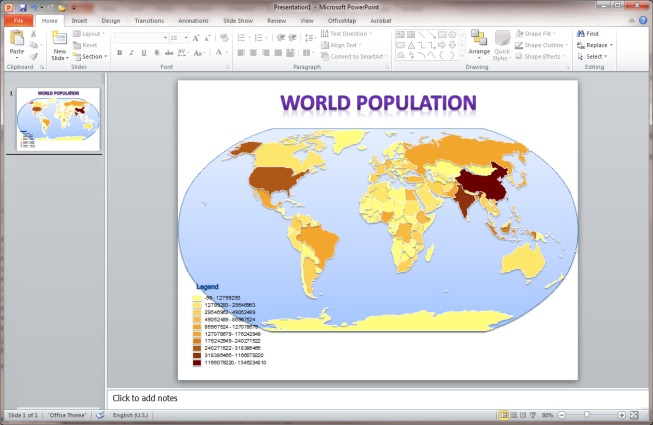COM.* 2014 Leading-Edge Tech Shows
MIT Driverless Car Tech Show
COMStar OfficeMap Tech Show
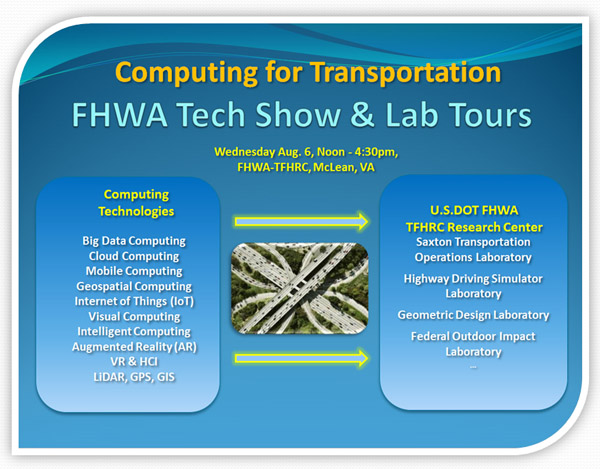

FHWA Intelligent Transportation Systems
Connected Vehicles / Vehicle-to-Infrastructure (V2I)
Big Data Computing in Transportation
Human Center Systems, Highway Driving Simulator (HDS)
Transportation Safety, Geometric Design, Crash Analysis and Simulation
Transportation GIS/GPS/LiDAR
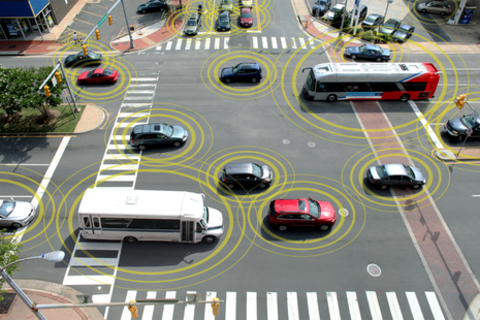 |
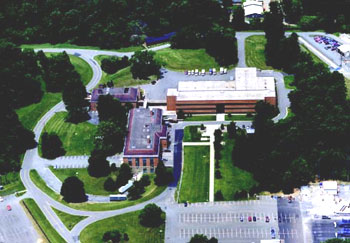 |
 |
| Image courtesy of USDOT keynote speaker Mr. Tim Schmidt and FHWA internet resources | ||
The FHWA Tech Talks, Demo Shows, Lab tours, and Test Drives will take place at Federal Highway Administration (FHWA) Turner-Fairbank Highway Research Center (TFHRC) on Wednesday afternoon Aug. 6, 2014. For more details, please see the COM.* 2014 program.
The TFHRC is the Nation’s premier federally owned and operated highway research and development facility. Located in McLean, VA as the research center for the FHWA, TFHRC coordinates and conducts an ambitious program of innovative highway research and development to address critical needs of the national highway system.
On July 15, 2014, U.S. President Obama visited FHWA-TFHRC and tested a self-driving car at a simulator of Highway Driving Simulator (HDS) Lab, then gave a speech on "the Importance of Our Nation's Infrastructure". The news was reported by the Whilte House, U.S. Department Transportation, The Washington Post, and FHWA, respectively.
 |
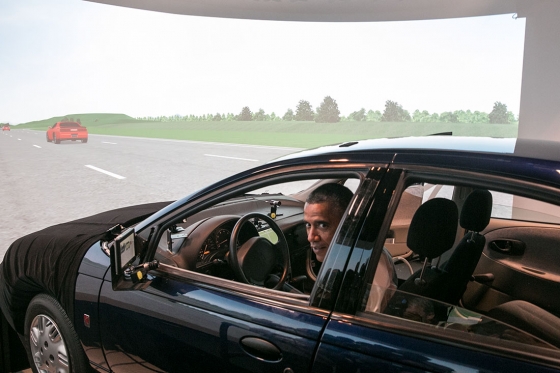 |
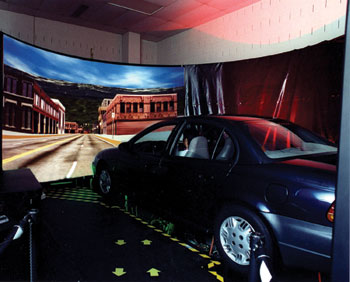 |
President Barack Obama delivers remarks on the economy at Turner-Fairbank Highway Research Center in McLean, Virginia, July 15, 2014. (Official White House Photo by Pete Souza) |
President Barack Obama prepares to drive a Saturn SL1 vehicle simulator during a tour of the Turner-Fairbank Highway Research Center in McLean, Va., July 15, 2014. (Official White House Photo by Amanda Lucidon) |
COM.* 2014 General Chair, Dr. Liao, drove the same vehicle simulator for developing the PC-clustered driving simulator system when she worked at HDS Lab as a key team member before. (Official FHWA Photo) |
PRE-REGISTRATION REQUIRED-- COM.*
2014 Attendees ONLY
Only a limited number of
COM.* 2014 attendees for this
tour are
available. Please
register here a.s.a.p.
Please Note: All participants 18 and older will need a government issued pictured identification card to gain access to the facility. Also, please keep in mind we have over 20 indoor and outdoor laboratories and weather can be a factor. There will be a lot of walking and standing; comfortable clothes and shoes are recommended.
SCHEDULE
12:30 PM
Bus leaves from the street corner of Marvin Center in DC to
TFHRC in McLean, VA
1:00 – 1:30 PM
Visitor Security Check (TFHRC Lobby)
1:30 – 4:30 PM
FHWA Welcome Remarks (Conference Room)
FHWA Tech Presentations (Conference Room)
FHWA Demo Shows (Conference Room & Labs)
FHWA Four Lab Tours (Four Labs)
FHWA Closing Remarks (Conference Room)
Visitor Security Sign Out (TFHRC
Lobby)
4:30 PM
Bus leaves from TFHRC (McLean, VA) and back to Marvin Center in
DC
For more details for the FHWA-TFHRC visit, please see the program adgenda.
TFHRC BACKGROUND
The
Turner-Fairbank Highway Research Center (TFHRC) is
the Nation’s premier federally owned and operated highway
research and development facility. Located in McLean, VA as the
research center for the Federal Highway Administration (FHWA),
TFHRC coordinates and conducts an ambitious program of
innovative highway research and development to address critical
needs of the national highway system. Through its three research
and development (R&D) offices – Infrastructure, Safety, and
Operations – along with the Exploratory Advanced Research
Program, FHWA engineers, scientists, and psychologists conduct
applied and exploratory advanced research in vehicle-highway
interaction, nanotechnology, and a host of other types of
transportation research in safety, pavements, highway structures
and bridges, human-centered systems, operations and intelligent
transportation systems, and materials. With more than 20
laboratories, the center provides a vital resource for advancing
the body of knowledge that has been created and developed by our
researchers.
TFHRC provides the world highway community with advanced and
applied research and development related to new and existing
highway technologies. The center reviews, tests, studies,
researches, and finds solutions to complex technical problems
through the development of more economical, environmentally
sensitive designs; more efficient, quality controlled
construction, operational, and safety practices; and more
durable materials. The end result is a safer, longer-lasting,
more reliable highway transportation system.
At times, when our expertise is requested, we also work with
FHWA’s Federal Lands Highway to test new solutions specifically
for Federal lands and parks, to make transportation facilities,
roads, or structures more aesthetically in tune with nature, yet
still function with the same high standards of other highway
structures and materials. We collaborate with other national
laboratories and agencies to address the needs of the Nation and
to keep American citizens safe in all parts of the world.
The Intelligent Co-Pilot: a Path toward Fully Autonomous Vehicles
This work demonstrates the "Intelligent Co-Pilot," a practical, near-term pathway to autonomous vehicle development. In this framework, the human driver and the autonomous control system share control authority, with the autonomous system generally only assuming control when the threat of an accident is significant. The system could also be tuned, however, to provide a greater degree of assistance. Such a system represents an attempt to reap the safety benefits of full autonomy, while ensuring that the operator remains attentive and responsible for high level decisions.
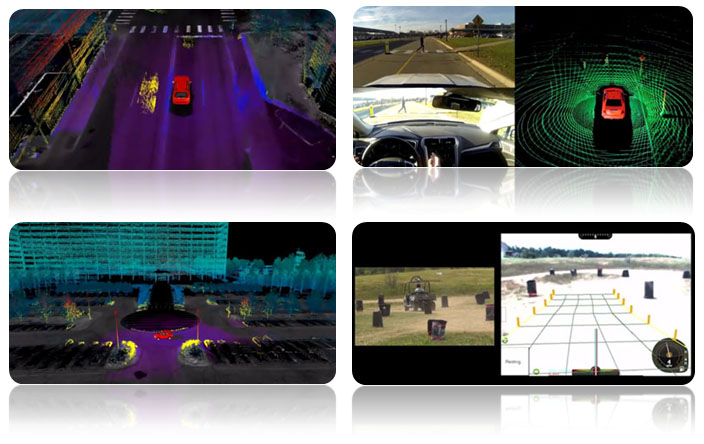
The Future with Self-Driving Cars
This work demonstrates work at SMART, the Singapore-MIT Alliance for Research and Technology, focused on development and testing of a new mobility-on-demand paradigm. This work, led by Professor Emilio Frazzoli of MIT, consists of a fleet of fully autonomous vehicles that can be summoned via smartphone by users to take them to a desired destination. The vehicles respond rapidly due to state-of-the-art backend software that positions the vehicles based on analysis of historical demand data. Analysis of transport data by the SMART researchers have shown that all of Singapore could be effectively served by such a mobility-on-demand paradigm, even while substantially reducing the overall number of vehicles on the road.
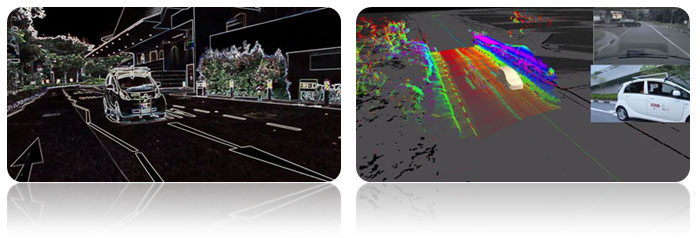
Save Time and Achieve the Best Map Results with OfficeMap for MS Office!
COMStar OfficeMap is the latest Microsoft PowerPoint Add-in. It provides a fast and easy way to directly create various kinds of maps on PowerPoint slides. OfficeMap offers many map templates. The map templates for MS Office is an impressive collection of dozens of categorized maps with appropriate projections for PowerPoint slides. They include world maps, continental maps, country maps, US state maps, and US county maps. All boundary maps and some satilliate maps are provided. OfficeMap offers three different symbol collections for simple symbols, color ramp symbols, and point symbols (i.e., markers, icons, and fonts). The maps created by OfficeMap are composed of PowerPoint shapes, texts, and pictures. All of operations for texts and illustrations in PowerPoint can be directly employed to those maps within PowerPoint. OfficeMap provides a friendly and powerful graphics user interface for users to easily insert the maps, select the symbols for the maps, and set the features for map shapes, texts, and pictures.
COM.* OfficeMap Tech Show Video
